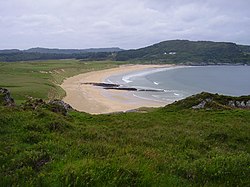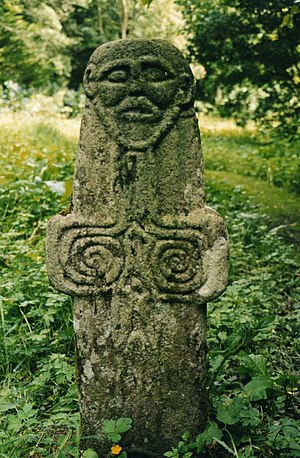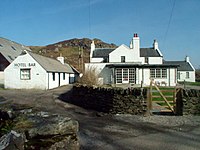Colonsay: Difference between revisions
No edit summary |
|||
| Line 25: | Line 25: | ||
==History== | ==History== | ||
===Mesolithic food industry=== | ===Mesolithic food industry=== | ||
In 1995 evidence of large-scale | In 1995 evidence of large-scale Mesolithic nut shelling, some 9,000 years ago, was found in a midden pit at Staosnaig on the island's sheltered east coast, in a large, shallow pit full of the remains of hundreds of thousands of burned hazelnut shells. Hazelnuts have been found on other Mesolithic sites, but rarely in such quantities or concentrated in one pit. The nuts were radiocarbon dated to 7720+/-110BP, which calibrates to circa 7000 BC. Similar sites in Britain and its dependencies are known only at [[Farnham]] in [[Surrey]] and [[Cass ny Hawin]] on the [[Isle of Man]].<ref name="Nuts1">[http://www.britarch.ac.uk/BA/ba5/ba5news.html "Mesolithic food industry on Colonsay"] (June 1995) ''British Archaeology''. No. 5. Retrieved 25 May 2008.</ref><ref name=Moff>Moffat, Alistair (2005) ''Before Scotland: The Story of Scotland Before History''. London. Thames & Hudson. p. 91–2.</ref> | ||
This discovery gives an insight into communal activity and forward planning of the period. The nuts were harvested in a single year and pollen analysis suggests that the hazel trees were all cut down at the same time.<ref name=Moff/> The scale of the activity is unparalleled elsewhere in the north. The pit was originally on a beach close to the shore, and there were two smaller stone-lined pits, whose function remains obscure, a hearth, and a second cluster of pits.<ref name="Nuts1"/> | This discovery gives an insight into communal activity and forward planning of the period. The nuts were harvested in a single year and pollen analysis suggests that the hazel trees were all cut down at the same time.<ref name=Moff/> The scale of the activity is unparalleled elsewhere in the north. The pit was originally on a beach close to the shore, and there were two smaller stone-lined pits, whose function remains obscure, a hearth, and a second cluster of pits.<ref name="Nuts1"/> | ||
Latest revision as of 12:32, 4 December 2015
| Colonsay Gaelic: Colbhasa | |
 An Tràigh Bhàn, Kiloran Bay | |
|---|---|
| Main village: | Scalasaig |
| Location | |
| Location: | 56°3’36"N, 6°12’36"W |
| Grid reference: | NR382938 |
| Area: | 10,067 acres |
| Highest point: | 469 ft |
| Data | |
| Population: | 144 |
Colonsay is an island of Argyllshire in the Inner Hebrides. It may be found north of Islay and south of Mull. It has an area of 10,067 acres. Aligned on a southwest to northeast axis, the island measures eight miles long and reaches three miles at its widest point.
This island was the ancestral home of Clan Macfie and the Colonsay branch of Clan MacNeil.
Geography and geology
Although Colonsay appears bare and somewhat forbidding on approach from the sea, its landscape is varied, with some sandy beaches, and a sheltered and fertile interior. It is linked by a tidal causeway (called The Strand) to Oronsay.
The Colonsay Group, which takes its name from the island, is a sequence of mildy metamorphosed Neoproterozoic sedimentary rocks an estimated 16,400 feet thick that also outcrop on the islands of Islay and Oronsay and the surrounding seabed. The sequence has been correlated with the Grampian Group, the oldest part of the Dalradian Supergroup.
History
Mesolithic food industry
In 1995 evidence of large-scale Mesolithic nut shelling, some 9,000 years ago, was found in a midden pit at Staosnaig on the island's sheltered east coast, in a large, shallow pit full of the remains of hundreds of thousands of burned hazelnut shells. Hazelnuts have been found on other Mesolithic sites, but rarely in such quantities or concentrated in one pit. The nuts were radiocarbon dated to 7720+/-110BP, which calibrates to circa 7000 BC. Similar sites in Britain and its dependencies are known only at Farnham in Surrey and Cass ny Hawin on the Isle of Man.[1][2]
This discovery gives an insight into communal activity and forward planning of the period. The nuts were harvested in a single year and pollen analysis suggests that the hazel trees were all cut down at the same time.[2] The scale of the activity is unparalleled elsewhere in the north. The pit was originally on a beach close to the shore, and there were two smaller stone-lined pits, whose function remains obscure, a hearth, and a second cluster of pits.[1]
Early history

There are a variety of ruined hill forts on the island such as Dùn Cholla and Dùn Meadhonach. The eighth century Riasg Buidhe Cross has been re-erected in the gardens of Colonsay House. St Cathan's Chapel may date from the 14th century. The ruins of the Chapel of St Mary are little more than foundations and may date to an even earlier period. In 1549, Dean Monro wrote that Colonsay was:
- "seven myle lange from the northeist to the southwest, with twa myle bredthe, ane fertile ile guid for quhit fishing. It hath ane paroch kirke. This ile is bruikit be ane gentle capitane, callit M’Duffyhe, and pertened of auld to Clandonald of Kyntyre.[3]
Ownership
During the 18th century the lairds of the island were Macneils, and included Archibald Macneil. Colonsay House was first built by the Mcneil family in 1722. Since 1904 the house has been the property of the island's later owners, the Barons Strathcona. Colonsay is owned by Donald Howard, 4th Baron Strathcona and Mount Royal and Colonsay House is currently occupied by his eldest son, Alexander Howard and his family.[4]
In 2013 Alexander Howard infuriated island residents, by accusing them of removing gravel from a beach without permission. Locals said that innocent people had been labelled "thieves" and "peasants". Howard later admitted the problem had been caused by builders from the mainland but failed to offer an apology to islanders.[5]
Present day
The island's population was 144 as recorded by the 2011 census; an increase of nearly 15% since 2001 when there were 108 usual residents. Colonsay's village is Scalasaig on the east coast, from where ferries sail to Oban and, between April and October, to Kennacraig by way of Port Askaig on Islay.
Recently there has been a growth of tourism as the mainstay of the island's economy, with numerous holiday cottages, many of them owned and managed by the Isle of Colonsay Estate. The Colonsay Hotel, the only hotel on the island, is also estate owned.[6]

The island has a tiny bookshop specialising in books of local interest; it is also the home of the House of Lochar publishing company specialising in history.[7] There is a hotel overlooking the harbour,[8] a cafe and bakery, and a shop and post office. In 2006 the former grass airstrip was upgraded and provided with a hard surface, in readiness for the introduction of a scheduled air service from Oban (Connel). This service began operating in June 2008 with morning and evening flights on Tuesdays and Thursdays.[9] The service is provided by Hebridean Air Services
Colonsay Community Development Company, the local development trust is “engaged in a range of work which reflects a sustainable approach to the regeneration of our island”. Current projects include running the islands coal supply and only petrol pump, a major Rhododendron ponticum eradication programme and a feasibility study into the possibility of improving the harbour and surrounding area.

2007 saw the opening of the Colonsay Brewery, a micro-brewery offering three different products.[10] Colonsay is the smallest island in the world with its own brewery.[11] The business employs two people, roughly ten per cent of the island workforce.
The nature of island life was exemplified by a story reported in 1993 that, at that time, the last recorded crime was treachery against the King (James VI) in 1623.[12] In November 2006 though four hundred years of peace was broken when a construction worker from Glasgow was arrested and confessed to theft by housebreaking having entered an unlocked house and stolen £60 in cash. Media interest was stirred when it was reported that this was the first recorded crime since 2004 and the "first ever theft from a house".[13] The next reported crime was in 2013 involving vandalism to a car.[14]
Colonsay may be the smallest island ever to host a rugby festival, all the more remarkable as there is no permanent rugby pitch.[15]
The arts
- I Know Where I'm Going!, a 1945 film by Michael Powell and Emeric Pressburger though principally shot on Mull refers to the fictional "Isle of Kiloran", which was based on Colonsay.[16]
- The Crofter and the Laird, a book by the American author John McPhee published in 1969 arose from his summer on Colonsay; McPhee is descended from a Colonsay emigrant.[17]
In 2008, Colonsay hosted the first ever Ceòl Cholasa, the island's own folk festival. This has now become an annual event and has seen performances by numerous well-known artists as well as performances from local island musicians.[18]
Since 2011 the island has held a three week "Festival of Spring" annually in May. Its aim is to encourage tourism onto the island, with events and activities led by both local inhabitants and visiting guest "speakers/experts".[19]
In 2012 the island staged its first book festival which featured, amongst others, Alexander McCall Smith, James Robertson, and Scots Makar Liz Lochhead. The line up for 2013 was headed by crime writer Ian Rankin.[20]
Wildlife
The island has a herd of wild goats, and is known for its bird life including Black-legged Kittiwake, Cormorant, Guillemot, Corncrake and Golden Eagle.
Colonsay and Oronsay host about 50 colonies of the only native species of honeybee in Britain–Apis mellifera mellifera. This bee has suffered serious declines on the mainland and from 1 January 2014 it has been an offence to keep any other species of honeybee on either island.[21]
Name
Colonsay's name derives from Old Norse and means "Kolbein's island"[22][23] (although Haswell-Smith offers "Columba's island").[24] In the 14th century the name was recorded as Coluynsay and by Dean Monro in the 16th century as Colvansay. The modern Gaelic is Colbhasa. [23]
Scalasaig also has a Norse derivation and means "Skali's bay".[25]
Picture
-
View over Colonsay and Oronsay to the right, the Paps of Jura in the distance
-
Between Cable Bay and Sir John's Pool on the south east coast with Islay in the distance.
-
Macfie Standing Stone
-
Dùn Eibhinn
Outside links
| ("Wikimedia Commons" has material about Colonsay) |
- Island at the Edge Colonsay produce
- Colonsay Brewery
- Island website
- Colonsay "Festival of Spring"
- Colonsay House and gardens
- The Corncrake, Colonsay's newsletter
- Colonsay Estate Website and Holiday Cottages
- On The Edge, documentary about Colonsay
References
- ↑ 1.0 1.1 "Mesolithic food industry on Colonsay" (June 1995) British Archaeology. No. 5. Retrieved 25 May 2008.
- ↑ 2.0 2.1 Moffat, Alistair (2005) Before Scotland: The Story of Scotland Before History. London. Thames & Hudson. p. 91–2.
- ↑ Monro (1549) "Colnansay" no. 84
- ↑ "The Estate". colonsayestate.co.uk. Retrieved 5 July 2010.
- ↑ Watson, Rachel (4 October 2013) "Anger as laird blames crofters in gravel dispute". Glasgow. The Herald
- ↑ "Colonsay Hotel" colonsayestate.co.uk. Retrieved 5 July 2010.
- ↑ House of Lochar Publisher. "Mission Statement". http://www.houseoflochar.com/sitefiles/mission.htm. Retrieved 2007-08-02.
- ↑ "Colonsay Hotel". http://www.thecolonsay.com. Retrieved 2007-08-02.
- ↑ "Argyll Flying High." Argyll-bute.gov.uk. Retrieved 20 September 2007
- ↑ "Colosay Brewery". http://www.colonsaybrewery.co.uk. Retrieved 2007-04-24.
- ↑ "Hebridean beer pioneers win battle of the tiny islands". http://www.scotsman.com/news/hebridean-beer-pioneers-win-battle-of-the-tiny-islands-1-1038849. Retrieved 2013-02-24.
- ↑ "Hebridean policeman's lot is a happy one". Herald Scotland. 21 June 1993. http://www.heraldscotland.com/sport/spl/aberdeen/hebridean-policeman-s-lot-is-a-happy-one-1.754403.
- ↑ Paterson. S. (2006-11-10). "Colonsay’s first house thief is fined £400". The Herald newspaper (Glasgow). http://www.islayblog.com/2006entries/20061110-colonsaycrime.shtml. Retrieved 2006-11-29.
- ↑ [http://www.scotsman.com/news/scotland/top-stories/first-crime-recorded-on-colonsay-for-seven-years-1-2982499 "First crime recorded on Colonsay for seven years"]. The Scotsman. 28 June 2013. http://www.scotsman.com/news/scotland/top-stories/first-crime-recorded-on-colonsay-for-seven-years-1-2982499.
- ↑ "Home" and "History". Colonsay Rugby Festival. Retrieved 9 December 2013.
- ↑ "Mull: I Know Where I'm Going" powell-pressburger.org. Retrieved 29 December 2009. Extract from Bruce, David (1996) Scotland the Movie. Polygon.
- ↑ The Crofter and the Laird amazon.com Retrieved 7 Feb 2011.
- ↑ "Ceol Chòlasa" ceolcholasa.co.uk. Retrieved 9 March 2014.
- ↑ "SpringFest 2014". Colonsayevents.co.uk. Retrieved 7 March 2014.
- ↑ "Home". Colonsay Book Festival. Retrieved 5 Sept 2012.
- ↑ "Colonsay and Oronsay to become honeybee havens". Edinburgh. Scotland on Sunday. Retrieved 7 October 2013.
- ↑ Mac Taillier (2003) p. 31
- ↑ 23.0 23.1 Watson (1926) p. 84
- ↑ Haswell-Smith, Hamish (2004). The Scottish Islands. Edinburgh: Canongate. ISBN 1841954543.
- ↑ Mac Taillier (2003) p. 103
- Haswell-Smith, Hamish (2004). The Scottish Islands. Edinburgh: Canongate. ISBN 1841954543.
- Monro, Sir Donald (1549) A Description Of The Western Isles of Scotland. Appin Regiment/Appin Historical Society. Retrieved 3 March 2007. First published in 1774.
- Watson, W J (1994) The Celtic Place-Names of Scotland. Edinburgh; Birlinn. ISBN 1841583235. First published 1926.
Coordinates: 56°4′N 6°13′W / 56.067°N 6.217°W




